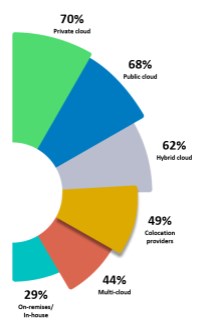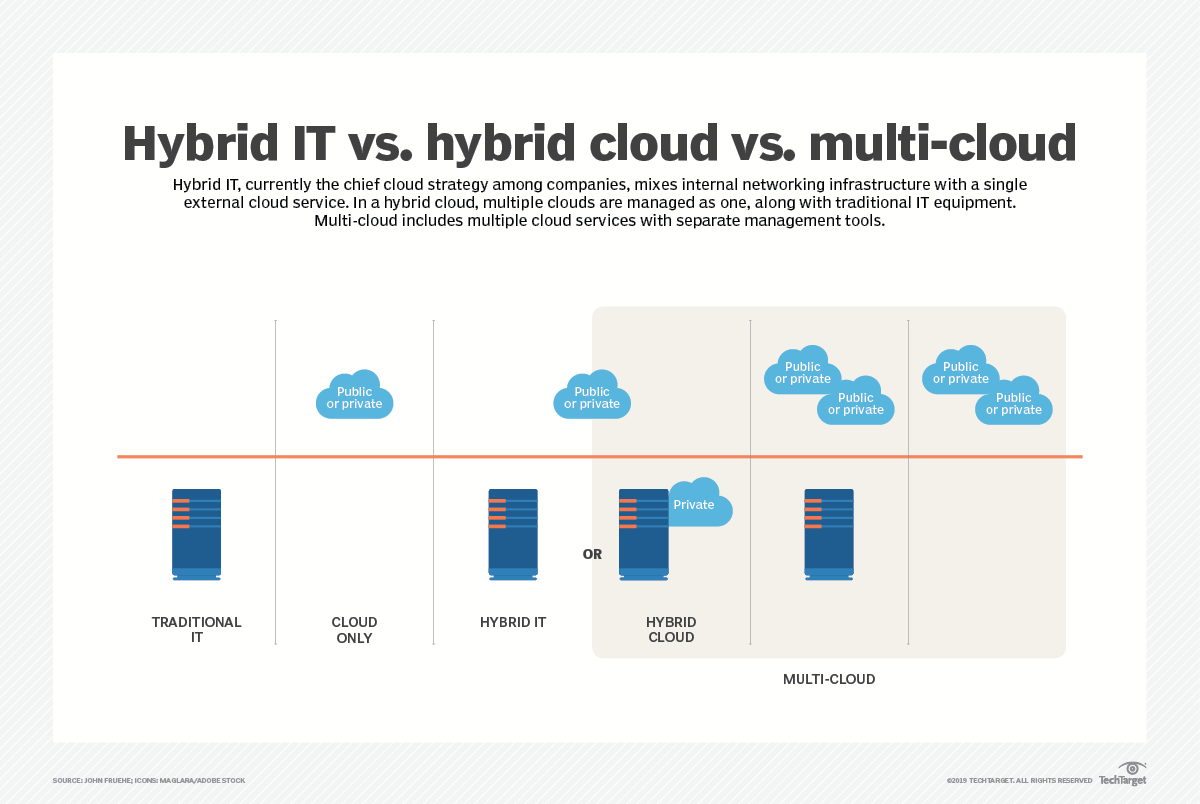
How to Think About Workload Placement

Long gone are the days when on-premises data centers were the center of the action. In a 2021 survey, respondents revealed what they’re using in their hybrid IT infrastructure mix: on-premises (29%), multicloud (44%), colocation (49%), hybrid cloud (62%), public cloud (68%) and private cloud (70%)¹. In fact, it is projected that 85% of infrastructure strategies will integrate these delivery options by 2025².
As the infrastructure mix changes for today’s digital ecosystems, so do considerations relevant to workload placement. Every decision has implications for risk, security, compliance, cost, performance, redundancy, diversity and resilience. And now edge computing is part of the workload placement discussion. All these variables complicate decisions, especially since decision makers have to put a stake in ground that’s constantly shifting.
On-Premises, Colocation, Cloud? Determine the Right Workload Placement Mix
Businesses continue to tune their infrastructure strategies by shifting workload distribution and turning services on and off. The trend, “cloud-first,” has given way to “cloud smart,” because each infrastructure option provides unique benefits and each business, especially as their digital transformation initiatives progress, has evolving requirements. The key is finding the right balance for workloads between on-premises, colocation data centers and cloud for your business objectives.
Let’s look at a few hybrid IT considerations that factor into workload placement decisions:
- Diversification – Relying on a single provider or single computing architecture increases risk. Diversification can make it easier to attract different kinds of customers, expand into new markets and meet your objectives for security, scalability and disaster recovery.
- Total Cost of Operation (TCO) – In the rush to the cloud, many enterprises went all in. But they’ve experienced unexpected cost increases, performance fluctuations, compliance issues or other concerns. As a result, enterprises are moving some workloads off public clouds to another cloud provider, into colocation (including bare metal servers) or back on-premises. Also, CapEx versus OpEx spending is a big part of TCO discussions. Part of the appeal of colocation is its flexible OpEx, pay-for-what-you-use pricing.
- Application Performance – How much latency is acceptable for your use case? Performance speed is affected by connectivity, servers, size of data, the task and distance. But blazing speed isn’t necessary for every application. Think about email compared to streaming video or IoT data transfers on which autonomous vehicle operation depends. Milliseconds matter in some cases, but not all.
- Control – Perhaps you’ve heard the expression, “colo is the new on-prem.” Dedicated or private clouds can be part of your company-owned data center or part of your colocation solution. Colocation offers the same control over data and platforms that you get with an on-premises data center – and it provides diverse, highly secure connectivity and technical support. But keep in mind for workload placement decisions that cloud environments can decrease control. Cloud providers own the infrastructure and management responsibilities are shared. As-a-service solutions such as IaaS and PaaS are the farthest behind the curtain.
Are there other technical, financial and operational considerations? Of course. The point is that you’ll want to be systematic about rating or prioritizing workload placement decisions by type of IT infrastructure (on-premises, colocation and so on) that suits your business processes, budget and revenue objectives.
Patterns of Workload Distribution
Despite the myriad variables that factor into workload location, patterns have emerged. Here are a few highlights from our State of the Data Center Report:
- Colocation is the platform of choice for performance-oriented core applications such as enterprise resource planning (ERP), content delivery/media processing, business intelligence (BI)/data warehouse and data analytics applications, and IoT applications.
- Cloud remains the preferred platform to run development/test as well as identity and access management workloads. Cloud is also dominant for storage/backup and archival workloads, especially for tiering storage for data that isn’t required day-to-day.
- Systems with personally identifiable information (PII) requirements are less likely to stay on-premises with each passing year (compare the 2021 State of the Data Center Report to learn more). Healthcare, utilities, financial services, education, and data-based services are just a few examples of industries that are subject to PII compliance regulations.
- Storage/backup, BI/data warehousing and other line-of-business (LoB) applications are moving away from the cloud.
- LoB, databases, ERP apps and data analytics, which all are key to digital transformation, are increasingly colocated.
- Workloads with sensitive data are likely candidates for colocation, not cloud.

Colocation Hybrid IT Advantages
Cloud adjacency puts hardware and dedicated workloads close to the public cloud and, for CoreSite customers, provides access to direct (“native”) cloud onramps. The result? Reduced latency and lower costs for data transfer. A few colocation providers offer direct connection to the major cloud service providers – an operating advantage that reduces data replication costs by as much as 70% and eliminates data egress costs when restoring data from certain local cloud availability zones.* Additionally, direct connections keep data off the internet and away from associated security vulnerabilities.
CoreSite is a colocation provider that supports an ecosystem consisting of enterprises, IT service providers, managed services providers, network operators, cloud service providers, content delivery networks and other businesses. Interconnection through cross connects and virtual interconnection services, leveraging the Open Cloud Exchange®, enables enterprises in the digital ecosystem to exchange data. Because they all are in the same data center, the connection is highly secure, it’s easy to do business together and there’s the opportunity to create frictionless customer experiences.
Also, when colocation is part of the hybrid IT infrastructure, enterprises are better able to optimize their IT staff’s productivity and computing resources. With fewer workloads to manage on-premises, for example, IT staffs can focus on ways to differentiate a business through innovative customer services, business process improvements, partnerships or other initiatives.
Nearly half of enterprises already use colocation in their hybrid IT mix. It’s the smart choice for many workload deployments, and the added bonus of a digital ecosystem and interconnection can accelerate digital transformation.
For more information, take a look at the 2021 State of the Data Center infographic and download the entire report. Further information about trends in moving top workloads to colocation data centers for a hybrid approach can be found in the newly published 2022 State of the Data Center Report.
*Cost savings are based on CoreSite cost comparisons using publicly available and private information and/or CoreSite customer reported costs savings and may not be indicative of the costs savings that may be experienced by every customer that switches to the applicable CoreSite service.
Note: This post is an update of a previous version with the same title. It now includes data sourced from the 2022 State of the Data Center Report.










